15 Red Ducks You Should Know
Red ducks are a striking sight in waterways around the world, from quiet ponds to rushing rivers. Their red feathers can range from deep chestnut to bright russet, making them easy to spot even from a distance. In some species, both males and females show rich red tones, while in others, the males are the ones with the most vivid coloring and the females display more subtle hues.
The red coloring can cover the entire body or appear in patches on the head, chest, or wings. Some red ducks keep their brilliant colors year-round, while others may change to softer shades outside of the breeding season. Here are 15 most common types of red ducks and the unique features that make each one special.
1. Redhead

The male Redhead duck is easy to recognize with its warm, copper-colored head and pale blue bill during breeding season. Its round head and yellow eyes set it apart from close relatives like the Canvasback. Redheads are diving ducks, built to search for food underwater — their legs are placed far back on their bodies, which makes walking on land tricky, but their strong, broad feet help them propel through water.
2. Red Shoveler
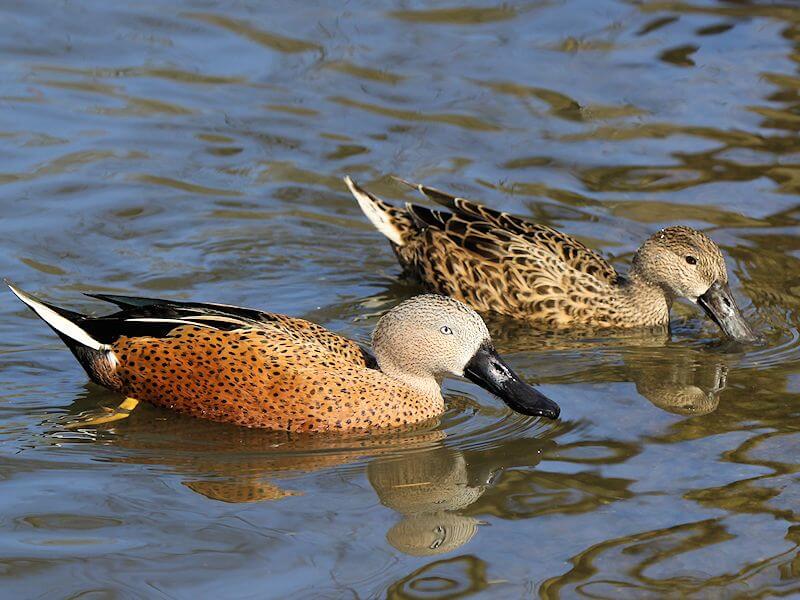
Male Red Shovelers display beautiful shades of red and pink, while females are more muted with large dark bills. These ducks live across southern South America, from Tierra del Fuego up through Argentina and Chile, and even in small pockets of Brazil and Uruguay. They love shallow lakes, reed-filled ponds, and coastal lagoons, where they use their wide, spatula-shaped bills to sift for food. Their bright red tones make the males stand out beautifully against green reeds and calm waters.
3. Red-crested Pochard

The Red-crested Pochard is a showy duck, with males sporting a rounded orange-red head, bright red bill, and black breast, while their sides are white and back brown. Females are softer, with pale brown plumage and a whitish face. These ducks breed in marshes and lakes across southern Europe and parts of Asia, and some migrate south to Africa or the Indian subcontinent for winter. They are diving ducks too, often seen dipping underwater for plants and small creatures, and their bold colors make them a favorite for anyone spotting them on a lake.
4. Andean Duck
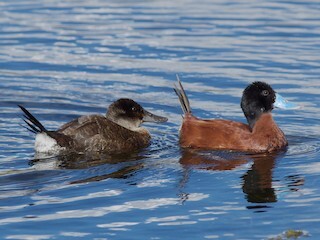
The male Andean Duck shows off a rich chestnut-red body in summer, paired with a bright blue bill that really catches the eye. These small, compact ducks have stiff tails that they often hold upright, and slightly peaked heads with short, thick necks. They live high in the Andes, in lakes and ponds, and are built for diving and scooping food underwater. In winter, their colors fade to gray-brown, and females and young males are mostly brown with a faint cheek stripe, making them harder to spot.
5. Cinnamon Teal

The male Cinnamon Teal is a beautiful sight, with glowing reddish plumage that sets him apart in marshes and ponds across western North and South America. Females are much duller, with brown feathers that help them blend in while nesting. These small dabbling ducks feed mostly on plants and seeds, often tipping forward in shallow water to reach their meals. Their bright red color is most noticeable in the breeding season, making the males easy to identify from a distance.
6. Common Pochard

The male Common Pochard has a warm chestnut-red head and neck, a black breast, and a pale gray body with fine markings. Its yellow-orange eyes become brighter during breeding season, adding to its striking appearance. These diving ducks prefer deeper lakes and marshes in Europe and northern Asia, where they search underwater for plants and small creatures. They migrate south in winter, making them a welcome sight in southern and western Europe.
7. Ruddy Shelduck

Ruddy Shelducks have glowing orange-brown bodies and paler heads, with black tails and flight feathers that contrast sharply with white wing patches. They breed in southeastern Europe and central Asia and migrate to the Indian subcontinent for winter. Known for their loud honking calls, these ducks are hard to miss when flying in flocks, and their striking red-orange plumage makes them a favorite among birdwatchers.
8. South African Shelduck
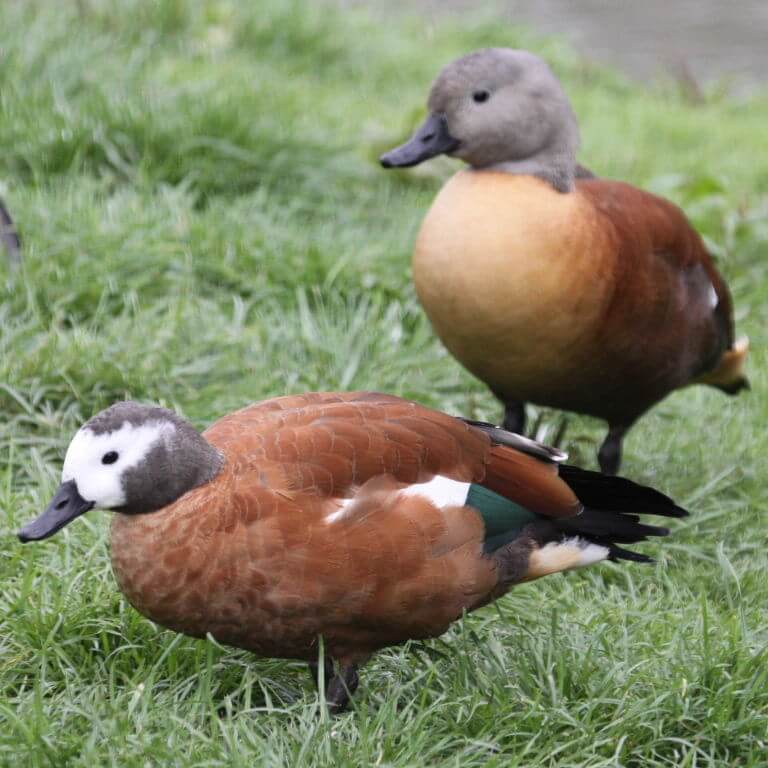
Adult South African Shelducks show off beautiful ruddy bodies with wings patterned in black, white, and green. Males have gray heads, while females have a striking white face with a black crown and neck sides. These ducks are often seen in wetlands and are popular in zoos and collections, though hybrids with other orange-plumaged shelducks can make identification tricky. Their bold colors and contrasting wing patterns make them a standout in any flock.
9. Ferruginous Duck

The male Ferruginous Duck is a deep, rich chestnut on its head, breast, and sides, with a bright white patch under the tail that flashes when it takes flight. Its yellow eyes contrast sharply with the dark plumage, while females are browner and subtler, with dark eyes. These diving ducks breed across a wide range from Iberia and North Africa to western Mongolia, though in some western areas they are now rare. Watching a male show off its bright chestnut feathers in the sunlight is a real treat for any birdwatcher.
10. Hartlaub’s Duck
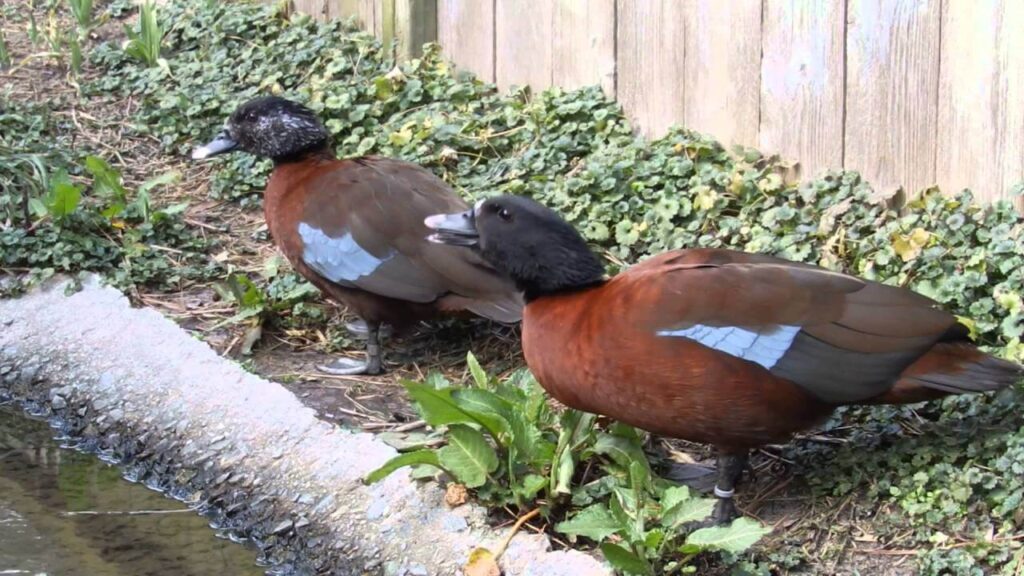
Hartlaub’s Duck, found in African forests, has a striking white head and reddish-brown eyes in adult males, making it easy to identify among the dark chestnut body. Females have very little white on their heads and darker red eyes. Both sexes feature a blue wing patch that sets them apart from other ducks. Juveniles start with pale-tipped feathers and develop the full adult coat in about six months. During mating season, males show a unique feature: the base of their bills enlarges, adding to their fascinating display.
11. Maccoa Duck
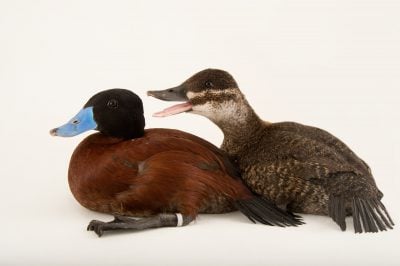
The male Maccoa Duck is a striking mix of colors, with a black head and throat, chestnut breast and back, greyish-brown underparts, and a cobalt blue bill. In flight, flashes of off-white underwing feathers and white under the wings are visible, making it easier to spot. Non-breeding males look more like females but still show hints of chestnut and a darker crown. These ducks live in nutrient-rich inland waters like lakes, ponds, and even river mouths, diving underwater for their meals and showing off their bright colors during breeding season.
12. Masked Duck
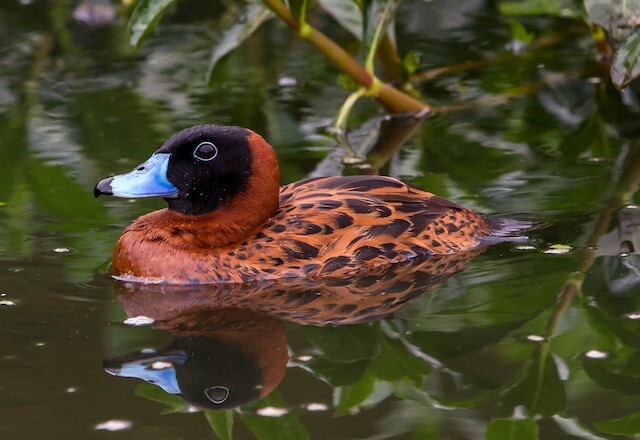
The male Masked Duck is a tiny but striking stiff-tailed duck, with a warm rust-colored body and a bold black face that makes it easy to spot. Its wings have subtle mottling, adding texture to its overall look. Females, winter males, and juveniles are much more muted, showing barred brownish-gray feathers and dark stripes across their buff-colored faces. These little ducks live in tropical wetlands in the Americas, often hiding among dense vegetation, which makes spotting a bright male feel like finding a treasure.
13. Ruddy Duck
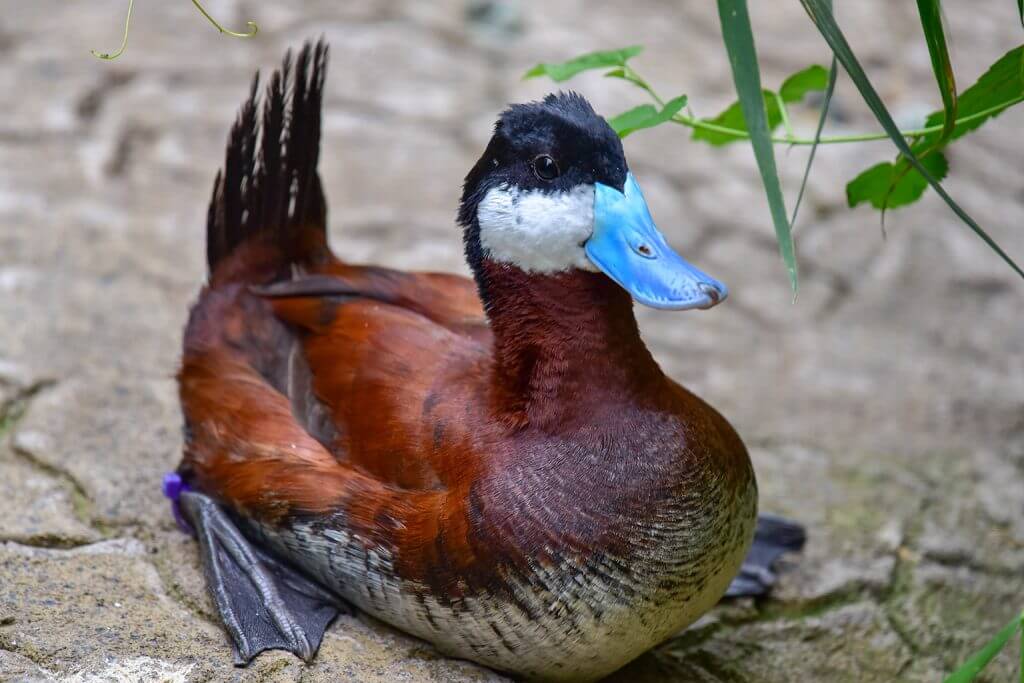
The male Ruddy Duck is instantly recognizable in summer, with a rich chestnut-red body, bright white cheeks, and a striking blue bill. Its black cap adds a dramatic contrast, while females and young males are duller, brownish with faint cheek stripes. These stiff-tailed ducks love heavily vegetated ponds and marshes, diving underwater to feed on plants and small creatures. Even in flight, their dark wing tops make them stand out, and males are noticeably larger than females.
14. White-headed Duck
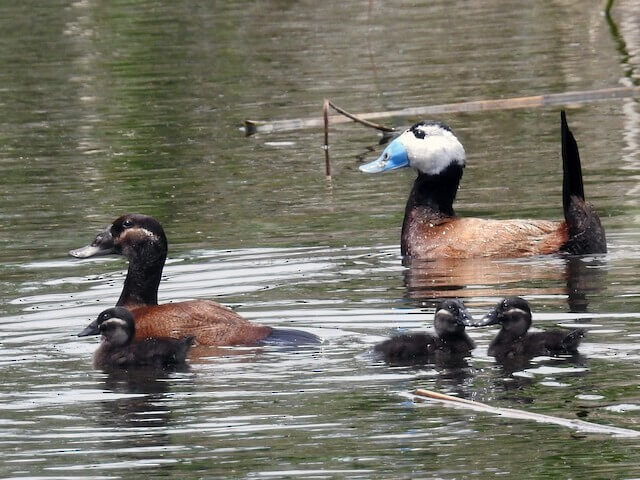
True to its name, the male White-headed Duck has a brilliant white head with a black crown, a blue bill, and reddish-gray body feathers. Females are more subdued, with darker bills and softer coloring. These small diving ducks prefer lakes with open water and plenty of plants along the edges, where they can hide and feed safely. Spotting a male gliding across the water with its clean white head is always a special sight.
15. Paradise Shelduck

Paradise Shelducks are bold and eye-catching: males have black heads with barred black bodies, while females sport white heads with warm chestnut-colored bodies. They are relatively large, weighing up to 2 kilograms, and are often seen in pairs, as they mate for life. These ducks mainly graze on grasses and clover but will eat insects and other small invertebrates too. Found throughout New Zealand, they molt each year and are hunted seasonally, yet remain common and are classified as a species of least concern.
